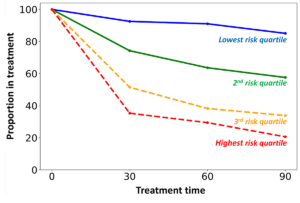Hot Off the Press – May 23, 2023
Published in Neuropsychopharmacology by Brenda Curtis and Salvatore Giorgi of the NIDA IRP Technology and Translational Research Unit in collaboration with other researchers.
Summary
Assessing an individual’s risk of substance use treatment dropout traditionally involves comprehensive, structured interviews which are time consuming and costly to administer. More accurate risk assessment would allow clinicians and treatment facilities to better allocate support resources to those in higher need. The current study suggests that digital phenotyping technologies (i.e., digital proxies of behavior and emotional states) could be used in tandem with standard clinical measures to produce more accurate risk measures for those entering treatment for substance use. The study uses state-of-the-art artificial intelligence and natural language processes methods to create digital phenotypes from participants’ past social media language. Clinical data and the language-based digital phenotypes, both collected at treatment intake, are then used to generate risk scores for each participant in order to predict future treatment adherence. Of the participants who were assigned low-risk scores at intake, nearly 80% remained in treatment after 90 days, whereas 20% of the high-risk participants remained. These results suggest that digital phenotypes are well equipped to capture heterogenous experiences which are predictive of substance use treatment dropout. Further, they can be used as a low cost, unobtrusive tool for clinicians to assess future risk of treatment dropout and allocate support resources to those with higher risk.
Publication Information
AI-based analysis of social media language predicts addiction treatment dropout at 90 days Journal Article
In: Neuropsychopharmacology, 2023, ISSN: 1740-634X.

